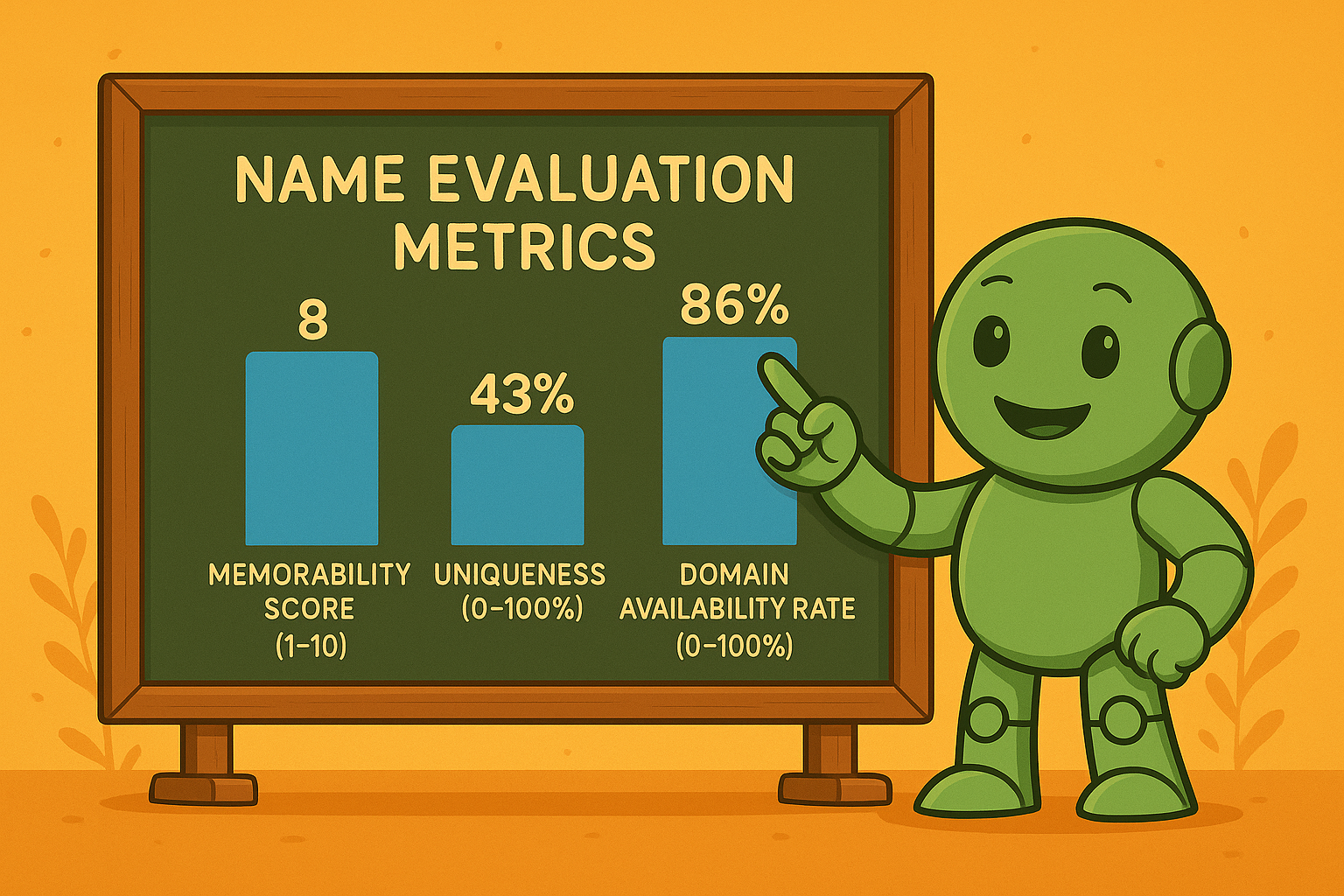Brainstorming Company Names: Battle-Tested Methods That Work
Why Brainstorming Company Names Is Harder Than Ever

Finding the perfect company name is more challenging than ever. The digital age has significantly changed the business landscape, making traditional naming methods inadequate. Simply choosing a descriptive name and checking for local trademark conflicts no longer suffices. Consider the sheer number of businesses operating online today.
Competition for attention is fierce, making a memorable name essential for success.
The Digital-First World Demands More
This increased competition isn't confined to local markets; it's global. The internet has removed geographical barriers, putting businesses of all sizes on one crowded platform. Furthermore, cultural nuances and sensitivities differ significantly across international markets.
A name that resonates well in one country could be inappropriate or even offensive in another. This requires a more strategic and globally mindful approach to naming.
Trademark Congestion and Domain Availability
Trademark congestion is another significant factor adding to the difficulty. With countless businesses already established, finding a unique and legally sound name is a growing challenge. This is compounded by the need for a corresponding domain name.
Even with a trademark-free business name, securing the matching .com domain can be difficult, if not impossible. This adds another layer of complexity. It's comparable to searching for a parking spot in a crowded lot – available options are scarce.
Furthermore, the digital marketplace requires a robust online presence. This means having not only a memorable domain name but also consistent handles across social media platforms. Securing these digital assets is crucial for brand building.
However, in the current climate, it often feels like a race against the clock. Thousands of new brands are launched every year, further intensifying the competition.
Adapting to a New Reality
Smart business owners are adapting to this challenging environment by embracing new strategies. They are going beyond basic brainstorming sessions and adopting more structured, data-driven approaches. This often involves the use of sophisticated naming tools and platforms.
NameRobot is one such platform that leverages AI and linguistic databases. It can generate creative and available name options. These advancements represent a shift from traditional methods, acknowledging the higher stakes involved in naming a company today. As of 2025, the challenge has grown due to global trademark hurdles and the crowded digital space.
Thousands of new brands launch annually, making it harder to find a unique, available, and strategically advantageous name. Learn more about this evolving landscape in Naming in 2025 Is Tricky.
Strategic Groundwork Before You Start Brainstorming
Before diving into the exciting process of brainstorming company names, it's crucial to lay a solid foundation. This essential preparation distinguishes amateur efforts from professional outcomes, ensuring your creative energy is focused and productive, minimizing the common feeling of being overwhelmed that often derails naming projects.
Understanding Your Competitive Landscape
Begin by thoroughly researching your competitive landscape. This involves identifying your main competitors and carefully analyzing their naming strategies. What kind of names are they using? Are they descriptive, abstract, or evocative? Gaining an understanding of the existing naming conventions within your industry provides valuable insights.
This knowledge helps differentiate your brand and avoid unintentional similarities. For example, if your competitors all use straightforward, descriptive names, a more abstract or creative approach might help your brand stand out.
Defining Your Brand Personality and Naming Criteria
Next, clearly define your brand personality. Is your brand playful or serious? Innovative or traditional? This personality should directly inform your naming criteria. Establish clear parameters, such as desired name length, style (modern, classic, etc.), and linguistic characteristics.
For instance, a tech startup aiming for a modern feel might prefer a short, impactful name, while a more traditional business, like a law firm, might choose a name that sounds more established. These criteria act as a filter during brainstorming, ensuring generated names align with your brand identity.
Before we move on to gathering stakeholder input, let's look at a comparison of essential pre-brainstorming steps and common mistakes:
The following table, "Pre-Brainstorming Checklist Comparison," outlines best practices for preparing to brainstorm a company name, highlighting why each step is essential and the common mistakes to avoid.
| Preparation Step | Why It Matters | Common Mistake | Best Practice |
|---|---|---|---|
| Competitive Landscape Analysis | Understands existing naming conventions and helps differentiate your brand | Ignoring competitor names and risking unintentional similarities | Research competitor names, analyze their styles, and identify opportunities for differentiation. |
| Brand Personality Definition | Ensures the name aligns with the brand's overall image and values | Not defining the brand personality leading to a mismatch between the name and the brand identity | Clearly articulate the brand's personality (e.g., playful, serious, innovative) before brainstorming names. |
| Naming Criteria Establishment | Provides clear guidelines for brainstorming and ensures generated names meet specific requirements | Lack of clear criteria leading to a disorganized and unproductive brainstorming process | Establish parameters like name length, style, and linguistic characteristics to guide the brainstorming process. |
This table highlights the importance of preparation and provides actionable steps to ensure a successful company naming process. By addressing these key areas upfront, you can avoid common pitfalls and set the stage for a fruitful brainstorming session.
Gathering Stakeholder Input
Gathering stakeholder input is crucial for building consensus and ensuring buy-in from key individuals. Identify key stakeholders, such as founders, investors, and even potential customers. Solicit their feedback on your defined brand personality, the established naming criteria, and any initial name ideas.
This collaborative approach fosters a sense of ownership and helps avoid disagreements later in the process. Additionally, gathering input from diverse perspectives can uncover potential blind spots and identify names with unintended meanings or cultural sensitivities, which is particularly important in today's globalized market.
Proven Brainstorming Techniques That Generate Winners

Turning your naming sessions into successful ventures requires proven brainstorming techniques. These methods consistently yield exceptional results for both seasoned naming consultants and in-house teams. They encompass everything from structured word mapping to more unconventional association exercises. Let's delve into some key techniques.
Word Mapping for Brainstorming Company Names
Word mapping begins with your core business offering and expands outward to related terms and concepts. For example, a coffee roaster might start with "coffee" and branch out to related terms like "roast," "beans," "aroma," "flavor," "morning," and "awake." This process helps uncover potential names that might otherwise be overlooked.
Furthermore, using a thesaurus can significantly expand your list of related words. This valuable tool provides synonyms and related terms to broaden your naming possibilities.
Unconventional Association Exercises
Thinking outside the box is essential for brainstorming company names. Unconventional association exercises can be particularly effective. Consider connecting your product or service to seemingly unrelated concepts.
For example, if developing project management software, you could associate it with a conductor leading an orchestra or a gardener cultivating a thriving garden. These unusual connections can inspire creative and unique names.
This method helps break free from conventional thinking, leading to fresh perspectives and innovative ideas.
Facilitating Productive Brainstorming Sessions
Productive brainstorming requires structure. Start by setting clear objectives and establishing ground rules for participation. Encourage open contributions, even if ideas initially seem unconventional.
Maintaining focus is also crucial. Regularly remind participants of the naming criteria and desired brand personality. For further insights on name generation, consider exploring resources like How to master business name generators.
Breaking Through Creative Blocks and Building Momentum
Creative blocks are inevitable during brainstorming. Prepare strategies to overcome these lulls. Consider shifting to a different brainstorming technique, taking a short break, or introducing an energizing activity.
Once initial ideas emerge, maintaining momentum is key. Encourage the team to build upon each other’s suggestions, combining and refining concepts. This collaborative approach can generate hundreds of potential names efficiently.
Remember, brainstorming aims for both quantity and quality. A diverse pool of options, from practical to imaginative, provides a solid foundation for the next phase: evaluation and selection. These techniques offer actionable steps to begin the naming process.
Creating Names That Connect With Today's Consumers
Modern consumers are discerning and seek authenticity and purpose from the brands they choose. This shift has significantly impacted how businesses develop company names. A name is no longer simply a label; it's a statement of values and a means of building a genuine connection.
Authenticity and Purpose in Modern Naming
Consumers gravitate towards brands that reflect their own values. Purpose-driven names that highlight a company's commitment to social responsibility or environmental sustainability, for example, can forge stronger emotional bonds with target audiences. A company specializing in eco-friendly products might choose a name evoking natural imagery, immediately communicating its core values.
Authenticity is also critical. Consumers easily detect inauthenticity. A name that feels contrived or misaligned with a company's actual practices can be detrimental. This highlights the importance of genuine brand values when brainstorming company names. For further inspiration, explore resources like looking beyond the obvious for name inspiration.
How Values Shape Naming Decisions
Current societal values heavily influence naming decisions. Growing awareness of sustainability is a key example. Consumers are more inclined to support businesses demonstrating environmental responsibility. Therefore, names reflecting this commitment can attract environmentally conscious customers.
Cultural sensitivity is also paramount in our globalized world. A name with positive connotations in one culture could be offensive or meaningless in another. Thorough research and careful consideration of cultural nuances are essential during the naming process.
The increasing focus on hyper-personalization and sustainability in branding further shapes naming strategies. Brands in 2025 prioritize building authentic relationships with their customers. This influences naming, with businesses seeking names that resonate with consumers and reflect their values. More on this trend can be found here: Top Branding Trends of 2025.
Evaluating Names for Future Growth
When developing company names, consider future brand expansion. A name suitable for a small startup might not be appropriate as the company grows into new markets or product categories. Selecting a name with long-term potential is vital and requires careful consideration of the company’s vision and future objectives.
A practical evaluation framework involves assessing whether names align with current market expectations and allow for future expansion. This approach helps ensure the chosen name remains a valuable asset as the business evolves, positioning the brand for ongoing success in a dynamic market.
Testing And Validating Your Top Name Candidates
Brainstorming potential company names is an exciting process, but it's essential to put those top contenders through rigorous testing and validation. This crucial step helps separate the strong candidates from the weak, eliminating guesswork and ensuring your chosen name resonates with your audience, aligns with your brand, and stands on solid legal ground.
Target Audience Testing: Does Your Name Resonate?
Begin by testing your top name candidates with your target audience. Utilize surveys, focus groups, or even informal conversations to gauge their initial reactions. Pay close attention to first impressions, memorability, and whether the name effectively communicates your brand message. Remember, a name that connects with one demographic might not resonate with another.
Legal Availability and Trademark Checks: Avoiding Costly Conflicts
After identifying names that resonate with your target audience, comprehensive trademark searches are vital. These searches, conducted across all relevant markets, protect you from legal issues and ensure your chosen name is available. Overlooking this step can lead to costly rebranding efforts later on. For further information, see our article on business brand name changes.
Digital Presence Assessment: Securing Your Online Identity
Checking domain name availability is crucial. Verify the availability of your top name candidates across relevant extensions, including .com, .net, and .org. Simultaneously, assess social media handle availability to maintain consistent branding across platforms. A readily available and memorable domain name is essential for online visibility.

The infographic above displays data on three key name evaluation metrics: memorability, uniqueness, and domain availability. While "Name A" scores a 9 on memorability, its uniqueness and domain availability are lower, at 60% and 20% respectively. "Name B" offers a balance across all three metrics, while "Name C," despite high uniqueness and domain availability, suffers from lower memorability. This emphasizes the importance of a balanced approach to name evaluation.
Pronunciation and Memorability: Easy to Say, Easy to Remember
How easy are your names to pronounce and remember? Consider the potential for mispronunciation or misspelling, particularly across different languages and cultures. A difficult-to-pronounce name can hinder brand recognition and word-of-mouth marketing.
Cross-Channel Consistency: Ensuring Your Name Works Everywhere
Evaluate how your chosen name translates across various marketing channels, from business cards and website headers to social media profiles and product packaging. Maintaining consistency across all touchpoints is key for building a strong brand identity. A long name, for instance, might not fit well on a business card.
Using Evaluation Frameworks and Scoring Systems
A structured scoring system introduces objectivity to the decision-making process. Assign weights to each evaluation criteria based on its importance to your business. This might include factors like memorability, uniqueness, domain availability, and brand alignment. This quantifiable approach highlights the candidates that best meet your overall requirements.
To further illustrate this concept, let's examine a sample scoring matrix:
Name Evaluation Criteria Matrix: A comprehensive scoring system for evaluating potential company names across multiple strategic dimensions
| Evaluation Criteria | Weight | Scoring Method | Red Flags |
|---|---|---|---|
| Memorability | 20% | 1-10 scale (1=low, 10=high) | Score below 5 |
| Uniqueness | 25% | Percentage based on trademark search results | <50% unique |
| Domain Availability | 20% | .com, .net, .org availability (yes/no) | No .com available |
| Brand Alignment | 25% | 1-5 scale (1=low alignment, 5=high alignment) | Score below 3 |
| Pronunciation | 10% | Ease of pronunciation across target languages | Difficult to pronounce in key markets |
By using a weighted scoring system like this, you can objectively compare names and make informed decisions. Remember to adjust the weights and criteria to reflect your specific business priorities.
Avoiding Costly Naming Mistakes Before They Happen

Brainstorming company names is a crucial first step for any new venture. However, avoiding costly mistakes is equally vital to long-term success. Even well-intentioned naming efforts can sometimes lead to significant setbacks. This section explores common pitfalls and provides effective strategies for navigating them.
Recognizing Potential Naming Issues
One common mistake is overlooking trademark conflicts. A seemingly unique name might already be registered by another business. This can lead to legal challenges and the significant expense of rebranding. For example, a small business might invest in marketing a new name, only to discover a larger corporation holds the trademark. This scenario could force a costly and time-consuming name change.
Another potential pitfall is neglecting cultural sensitivity. A name that resonates positively in one culture could be offensive or have unintended negative connotations in another. This can severely damage your brand reputation, particularly when expanding internationally. Thorough research during the brainstorming process is essential to mitigate this risk.
Proactive Steps to Protect Your Investment
Taking proactive measures is crucial for avoiding naming problems. A fundamental first step is conducting comprehensive trademark searches across all relevant markets. This due diligence minimizes the risk of future legal battles and protects your brand identity.
Additionally, seeking feedback on potential names from diverse groups can uncover hidden cultural misunderstandings. Gathering perspectives from various backgrounds can help identify potential issues before they impact your brand. Domain name availability is another critical factor.
Failing to secure a relevant domain name can significantly limit your online presence and hinder your marketing efforts. Ideally, secure the .com domain for your chosen name to maximize online visibility and user accessibility. If the .com domain isn't available, consider alternative extensions like .net or .org.
Recovery Strategies After Launch
Even with careful planning, naming issues can sometimes surface after a product or company launch. If problems arise, swift action is essential to mitigate potential damage. Developing a robust rebranding strategy is crucial for minimizing negative impact and regaining market traction. This might involve slightly revising the name, clarifying its meaning through marketing campaigns, or engaging in public relations efforts to address concerns.
Furthermore, social listening plays a vital role in monitoring public perception of your brand name. Tracking online conversations and social media mentions can reveal potential negative connotations or misunderstandings that might be developing. Addressing these issues proactively, before they escalate, can prevent long-term damage to your brand reputation.
Transforming Your Name Into A Powerful Brand Asset
Selecting the perfect name is just the first step. The real work lies in transforming that name into a powerful brand asset. This requires a strategic approach, ensuring your chosen name resonates with your target market and drives business growth.
Securing Your Digital Foundation
Once you've chosen your company name, immediately secure essential digital properties. This includes registering your domain name, ideally with a .com extension. Simultaneously, claim relevant social media handles across all platforms you plan to use. This establishes a consistent online presence and prevents others from capitalizing on your brand name.
Developing Comprehensive Brand Guidelines
Develop brand guidelines to maintain consistency in how your name is presented, both visually and verbally. These guidelines should define your logo, color palette, typography, and overall brand voice. This creates a unified brand experience across all customer touchpoints, from your website and marketing materials to customer service interactions.
Integrating Your Name Across All Touchpoints
Consistently integrate your chosen name across every customer interaction. This builds brand recognition and reinforces your brand identity in the market. Ensure consistent usage on your website, social media profiles, email communications, packaging, and any physical storefront signage.
Measuring Naming Success: Metrics That Matter
How do you know if your new name is working? Establish key performance indicators (KPIs) to track brand awareness, customer engagement, and website traffic. Monitor social media mentions and online reviews to understand public perception. These data points provide valuable insight into how your name is received, allowing for strategic adjustments if necessary.
Adapting and Evolving Your Brand Story
Markets change, and your brand should evolve with them. Remain flexible and willing to adapt your brand story as your business grows. This might involve refining your messaging, expanding your product offerings, or targeting new customer segments. Your name provides a foundation, but your story should resonate within the current market.
This holistic approach transforms a good name into a valuable asset. It translates your initial investment into tangible business value and provides a long-term competitive advantage. Check out NameRobot to help find the perfect name for your new venture.















